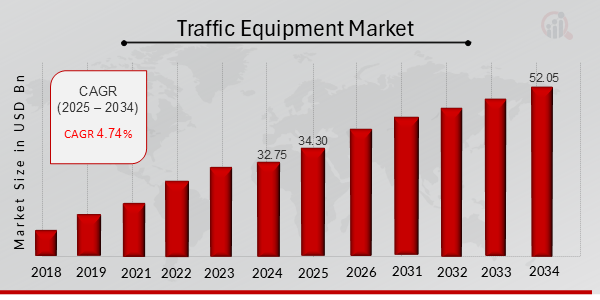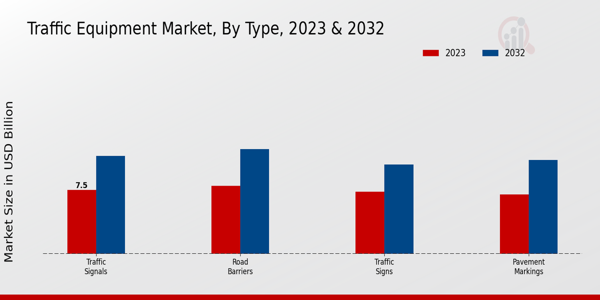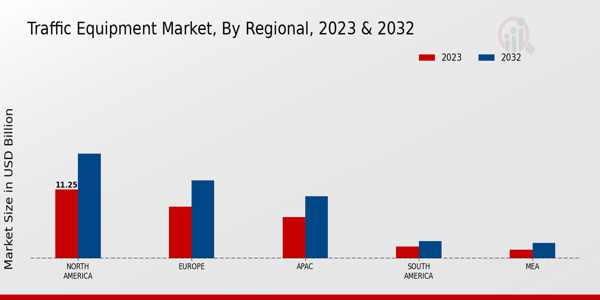Global Traffic Equipment Market Overview
As per MRFR analysis, the Traffic Equipment Market Size was estimated at 32.75 (USD Billion) in 2024. The Traffic Equipment Market Industry is expected to grow from 34.30 (USD Billion) in 2025 to 52.05 (USD Billion) till 2034, at a CAGR (growth rate) is expected to be around 4.74% during the forecast period (2025 - 2034).
Key Traffic Equipment Market Trends Highlighted
The Traffic Equipment Market is experiencing significant growth driven by the rising need for smart transportation solutions. Urbanization, population growth, and the increasing number of vehicles on the roads are compelling governments and municipalities to invest in advanced traffic management systems.
Additionally, growing concerns about safety and traffic-related incidents are pushing stakeholders to adopt innovative traffic equipment, improving efficiency and reducing accidents.
This trend highlights the urgent need for better infrastructure and real-time monitoring technologies that can address congestion and enhance road safety. There are ample opportunities in the market that can be explored to capture growth.
The demand for sustainable and environmentally friendly equipment is on the rise, urging companies to innovate and provide energy-efficient solutions. The integration of IoT devices and smart technologies offers avenues to develop advanced traffic management systems that can optimize traffic flow and reduce environmental impacts.
Furthermore, the expanding use of electric vehicles presents a chance for manufacturers to create specialized traffic management solutions tailored for this emerging vehicle category. Investing in research and development to innovate these technologies can position companies advantageously in this competitive landscape.
Recent trends indicate a shift towards integrated traffic solutions that encompass various modes of transportation. The rise of connected vehicles and smart cities is prompting a focus on comprehensive traffic systems that work cohesively to improve urban mobility.
Digitalization and automation are also becoming pivotal, as real-time data analytics can significantly enhance traffic monitoring and management. This evolving landscape encourages stakeholders to reassess traditional approaches and leverage new technologies that promise to enhance urban infrastructure.
As cities continue to evolve, the emphasis on smarter, safer, and more efficient traffic systems will remain a central theme in the Traffic Equipment Market.

Source: Primary Research, Secondary Research, MRFR Database and Analyst Review
Traffic Equipment Market Drivers
Growing Urbanization and Infrastructure Development
The rapid pace of urbanization is one of the primary drivers of growth in the Traffic Equipment Market.
As more people flock to urban areas in search of better economic opportunities and living conditions, the demand for efficient traffic management solutions becomes increasingly critical. Urban centers often face congestion and inefficient traffic flow, leading city planners and governments to invest heavily in traffic equipment to address these issues.
Infrastructure development plays a crucial role in this context. As cities expand, the need for improved roads, parking systems, traffic signals, and other related equipment surges. These projects often receive funding from both public and private sectors, promoting a healthy environment for manufacturers and suppliers in the Traffic Equipment Market.
As the urban population continues to grow, it is expected that this will create a sustained demand for advanced traffic solutions.
Innovations such as smart traffic management systems, which utilize real-time data and AI technology, are increasingly seen as essential tools to streamline urban mobility. This trend is likely to propel market growth significantly in the coming years, particularly as the focus shifts towards sustainable and smart city initiatives.
By investing in advanced traffic equipment, cities aim to reduce congestion, enhance safety, and improve overall transportation efficiency, thereby fostering an environment conducive to economic growth and enhanced quality of life.
Increased Government Initiatives and Regulations
Government initiatives aimed at improving road safety and reducing accidents are a significant driver in the Traffic Equipment Market.
Many countries are implementing stricter regulations concerning vehicle inspections, traffic rules, and equipment standards to improve overall safety on the roads. This results in increased sales and demand for traffic equipment, including traffic signals, signage, and road monitoring systems.
Furthermore, government funding often supports infrastructure projects that require modern traffic equipment. Such initiatives encourage manufacturers to innovate and expand their product offerings to meet regulatory standards and consumer needs.
Technological Advancements and Smart Traffic Solutions
The integration of advanced technologies into traffic management has become a prominent driver in the Traffic Equipment Market. Innovations such as vehicle-to-infrastructure (V2I) communication, smart traffic lights, and real-time monitoring systems are gaining traction.
These technologies not only help in managing traffic flow efficiently but also enhance safety measures for pedestrians and drivers alike. As cities evolve into smart hubs, the investment in such technologies becomes vital, ensuring a robust market for traffic-related equipment and solutions.
Traffic Equipment Market Segment Insights
Traffic Equipment Market Type Insights
The market encapsulates various types of traffic control devices, with primary components such as Traffic Signals, Road Barriers, Traffic Signs, and Pavement Markings contributing significantly to its overall valuation.
Among these, Traffic Signals held a market value of 7.5 USD Billion in 2023 and are expected to escalate to 11.5 USD Billion by 2032. Their importance was underscored by their role in regulating vehicle and pedestrian movement, preventing chaos at intersections, and enhancing road safety, thus holding a majority significance in the overall market.
Road Barriers followed closely with a valuation of 8.0 USD Billion in 2023, forecasted to reach 12.3 USD Billion by 2032. These barriers were vital in ensuring the safety of both motorists and pedestrians by delineating roadway boundaries and minimizing the risk of accidents, demonstrating a significant role in the traffic equipment sector.
Traffic Signs, with a market value of 7.3 USD Billion and expected to grow to 10.5 USD Billion in 2032, served as essential guides for drivers and pedestrians alike, effectively communicating regulations, warnings, and important information, hence their considerable impact on roadway safety and traffic management.
Pavement Markings, valued at 7.0 USD Billion in 2023 and projected to rise to 11.0 USD Billion by 2032, also contributed meaningfully to the market. These markings play a crucial role in guiding traffic flow, indicating lanes, and enhancing safety on the roads.
The Traffic Equipment Market segmentation reflects a balanced distribution among these types, though Traffic Signals and Road Barriers are particularly dominant due to their direct influence on safety and traffic efficiency.
Overall, the interplay of these segment types exhibits the crucial nature of traffic management equipment in fostering safer and more efficient roadways, justifying the market growth and continued investment in this sector. The increasing focus on urban infrastructure development and smart city initiatives further supports the ongoing demand for these essential traffic equipment components.

Source: Primary Research, Secondary Research, MRFR Database and Analyst Review
Traffic Equipment Market Application Insights
The Systems, and Highway Management, each contributing to the market's overall dynamics. Urban Traffic Management is essential for regulating and optimizing traffic flow in metropolitan areas, thereby enhancing safety and reducing congestion. Construction Sites require specialized equipment to ensure safety and efficiency as infrastructure development ramps up globally.
Public Transport Systems are vital for promoting sustainable transit options, and their expansion increases the demand for effective traffic solutions. Furthermore, Highway Management plays a critical role in ensuring smooth connectivity and infrastructure resilience.
As the Traffic Equipment Market segmentation evolves, opportunities for technological advancements and sustainable practices will shape industry trends, addressing challenges such as urbanization and efficient resource utilization while expanding the potential for revenue growth.
Traffic Equipment Market Material Insights
The Traffic Equipment Market has been experiencing a robust growth trajectory, with the Material segment playing a crucial role in this expansion.
The segment is predominantly influenced by materials such as Metal, Plastic, Wood, and Composite, each of which contributes uniquely to market dynamics. Metal holds a significant position due to its strength and durability, making it ideal for infrastructure components.
Plastic is increasingly favored for its lightweight properties and cost-effectiveness, enhancing the efficiency of traffic management solutions. Meanwhile, Wood finds relevance in sustainable applications, catering to an eco-conscious clientele, while Composite materials are gaining traction in advanced applications for their superior strength-to-weight ratio.
Collectively, these materials reflect trends in sustainability and innovation that are reshaping the traffic equipment industry, supported by the evolving Traffic Equipment Market revenue statistics and segmentation insights.
As such, businesses are poised to capitalize on growth drivers like infrastructure development and urbanization while navigating challenges related to material sourcing and environmental regulations.
Traffic Equipment Market End Use Insights
Among the various end-use applications, the Government sector plays a crucial role, primarily due to the increasing need for efficient traffic management and infrastructure development. Construction Companies are also significant contributors, leveraging traffic equipment to enhance project efficiency and ensure safety during large-scale operations.
The Private Sector's involvement continues to expand, focusing on the adoption of advanced traffic solutions to optimize transportation networks. Each of these segments offers distinct opportunities, particularly as urbanization increases and the demand for improved traffic management solutions rises.
Furthermore, the growing emphasis on sustainability encourages investments in innovative traffic equipment, thereby influencing the market dynamics positively. Overall, the Traffic Equipment Market segmentation highlights the importance of these end-use categories in driving growth and adapting to evolving transportation needs.
Traffic Equipment Market Regional Insights
Dominating the market, North America was valued at 11.25 USD Billion, reflecting its significant role due to advanced infrastructure and technology adoption. Europe followed closely, valued at 8.43 USD Billion, benefiting from stringent traffic regulations and safety standards that drive demand.
The APAC region was valued at 6.75 USD Billion, with rapid urbanization and increasing investments in transportation infrastructure contributing to its growth prospects. South America and MEA held smaller shares at 1.95 USD Billion and 1.47 USD Billion, respectively, but they signify emerging markets with untapped potential.
These regions were gradually developing their traffic management systems, highlighting opportunities in the Traffic Equipment Market.
The overall market statistics indicate noticeable growth opportunities across all regions, predominantly influenced by evolving urban mobility trends and increasing concern for safety on roads, positioning these markets for ongoing growth and development in the coming years.

Source: Primary Research, Secondary Research, MRFR Database and Analyst Review
Traffic Equipment Market Key Players and Competitive Insights
The Traffic Equipment Market is characterized by a dynamic landscape with numerous players vying for dominance through innovative solutions and robust distribution networks. This market encompasses a wide array of products, including traffic signals, road signs, barriers, and surveillance equipment, all designed to enhance transportation efficiency and safety.
Competitive insights reveal that companies are engaging in strategic alliances, technological advancements, and comprehensive marketing strategies to capture a greater market share. The necessity for smart traffic systems amidst urban congestion and the push for road safety regulations are key factors driving competition.
As urban areas expand and technology evolves, the market continues to grow, prompting stakeholders to focus on sustainability, cost-effectiveness, and integration of advanced technologies. Gamber Johnson is recognized in the Traffic Equipment Market for its commitment to delivering high-quality mounting solutions and ruggedized mobile equipment.
The company boasts a strong market presence bolstered by its extensive experience and deep understanding of client needs, providing products that enhance the functionality and safety of traffic management systems. Gamber Johnson's robust engineering capabilities enable it to offer customized solutions that meet specific operational requirements in diverse environments.
Its reputation for reliability is a critical strength, as is its focus on compliance with rigorous industry standards, which ensures that its products are well-regarded by professionals in the field. Furthermore, Gamber Johnson's dedication to customer service and support enhances its competitive edge, fostering long-term relationships and customer loyalty.
Verra Mobility stands out in the Traffic Equipment Market with its comprehensive suite of services that integrates technology and operational excellence. The company specializes in solutions for automated enforcement, which encompasses speed enforcement and red-light cameras, positioning itself as a leader in traffic management technology.
Verra Mobility's strength lies in its innovative approach to data analysis and software development, which aids in improving the efficiency of traffic monitoring and enhancing public safety. Its strategic partnerships with government entities and municipalities facilitate a broad reach, making its solutions indispensable in modern urban planning.
Additionally, Verra Mobility is adept at adapting to regulatory changes, ensuring that its offerings remain in alignment with current traffic laws and safety standards, further solidifying its role as a key player in the market.
Key Companies in the Traffic Equipment Market Include
- Gamber Johnson
- Verra Mobility
- Trafficware
- TransCore
- Kapsch TrafficCom
- Iteris
- Cubic Corporation
- McCain
- Stimson Traffic
- QFree
- Intertraffic
- Sierra Wireless
- Siemens
- Xcelerator
- FLIR Systems
Traffic Equipment Market Developments
Recent developments in the Traffic Equipment Market indicate a vibrant landscape driven by technological advancements and strategic partnerships. Companies like Siemens and Kapsch TrafficCom are actively investing in smart traffic solutions to enhance operational efficiency and sustainability.
Verra Mobility has expanded its offerings through strategic collaborations, focusing on enhancing mobility services in urban areas. Trafficware and Iteris are enhancing their traffic management systems with AI capabilities, allowing for smarter decision-making in real-time traffic situations.
In terms of customer demand, there's a noticeable shift towards integrated solutions that combine software and hardware for efficiency. Merger and acquisition activity is evident, with Gamber Johnson and Sierra Wireless exploring potential partnerships to expand their product offerings.
Notably, Transcore's acquisition strategy has strengthened its position in the tolling and traffic management sector. The increasing emphasis on reducing congestion and improving road safety is leading to investments that are pushing market valuations, with some companies reporting significant growth in revenue streams, further impacting the competitive dynamics of the market positively.
Companies like Cubic Corporation and McCain are also focusing on innovative technologies to stay ahead and respond to these changing market demands.
- Traffic Equipment Market Segmentation Insights
- Traffic Equipment Market Type Outlook
- Traffic Signals
- Road Barriers
- Traffic Signs
- Pavement Markings
- Traffic Equipment Market Application Outlook
- Urban Traffic Management
- Construction Sites
- Public Transport Systems
- Highway Management
- Traffic Equipment Market Material Outlook
- Metal
- Plastic
- Wood
- Composite
- Traffic Equipment Market End Use Outlook
- Government
- Construction Companies
- Private Sector
| Report Attribute/Metric |
Details |
|
Market Size 2024
|
32.75 (USD Billion)
|
|
Market Size 2025
|
34.30 (USD Billion)
|
|
Market Size 2034
|
52.05 (USD Billion)
|
|
Compound Annual Growth Rate (CAGR)
|
4.74% (2025 - 2034)
|
|
Report Coverage
|
Revenue Forecast, Competitive Landscape, Growth Factors, and Trends
|
|
Base Year
|
2024
|
|
Market Forecast Period
|
2025 - 2034
|
|
Historical Data
|
2019 - 2023
|
| Market Forecast Units |
USD Billion |
| Key Companies Profiled |
Gamber Johnson, Verra Mobility, Trafficware, Transcore, Kapsch TrafficCom, Iteris, Cubic Corporation, McCain, Stimson Traffic, QFree, Intertraffic, Sierra Wireless, Siemens, Xcelerator, FLIR Systems |
| Segments Covered |
Type, Application, Material, End Use, Regional |
| Key Market Opportunities |
Smart traffic management systems, Electric vehicle charging solutions, Sustainable construction materials, Autonomous vehicle infrastructure, Enhanced safety and security measures |
| Key Market Dynamics |
Technological advancements in equipment, Increasing road safety regulations, Growing urbanization and traffic congestion, Demand for smart traffic solutions, Rise in electric vehicle infrastructure |
| Countries Covered |
North America, Europe, APAC, South America, MEA |
Frequently Asked Questions (FAQ) :
The Traffic Equipment Market is expected to be valued at 52.05 USD Billion by the year 2034.
The expected CAGR for the Traffic Equipment Market from 2025 to 2034 is 4.74%.
North America is projected to have the highest market value at 17.07 USD Billion in 2032.
The market value for Traffic Signals was 7.5 USD Billion in 2023 and is expected to reach 11.5 USD Billion by 2032.
The market size for Road Barriers is expected to be 12.3 USD Billion by 2032.
Key players in the market include Gamber Johnson, Verra Mobility, Trafficware, and TransCore, among others.
The market value for Traffic Signs is expected to be 10.5 USD Billion in 2032.
The market value for Pavement Markings was 7.0 USD Billion in the year 2023.
The market is segmented into North America, Europe, APAC, South America, and MEA.
The expected market size for the APAC region is 10.11 USD Billion by the year 2032.

















